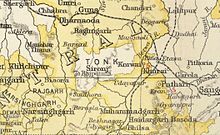Rajgarh State
| Rajgarh State राजगढ़ रियासत | |||||||
|---|---|---|---|---|---|---|---|
| Princely State of British India | |||||||
| Late 15th century–1948 | |||||||
|
Flag | |||||||
 Rajgarh State in the Imperial Gazetteer of India | |||||||
| Area | |||||||
• 1931 | 2,435 km2 (940 sq mi) | ||||||
| Population | |||||||
• 1931 | 134,891 | ||||||
| History | |||||||
• Established | Late 15th century | ||||||
| 1948 | |||||||
| |||||||

Rajgarh State (Hindi Name: राजगढ़) was a princely state in India, named after its capital Rajgarh, Madhya Pradesh. It was part of the colonial Bhopal Agency of the Central India Agency during the British Raj.[citation needed]
Rajgarh had an area of 2,492 Square Kilometers (940 sq. miles) and a population of 88,376 in 1901. Estimated revenue, 33,000 rupees (1911); tribute (to Sindhia of Gwalior) 3,640. The state revenue reached Rs.450,000 in 1901, the privy purse was Rs.140,000 rupees. Grain and opium were the principal articles of trade.[1][2]
History
There was a predecessor state known as Umatwara, whose chief received the princely title of Rawat (equivalent to Raja) in 1448.[citation needed]
In 1681 the state was divided into Rajgarh and Narsinghgarh State between the two sons of the Rawat Chhatar Singh, Rawat Mohan Singh and Rawat Parasramji. The daughter Mrinalini fled to the Himalayas and named her new seat (in present Himachal Pradesh) Rajgarh as well.[citation needed]
After India's independence in 1947, the last ruling Raja acceded to the Indian government on 15 June 1948.[3] Rajgarh became part of Madhya Bharat state, which was formed out of the western half of the Raj's Central India Agency of princely states. In 1956 Madhya Bharat was merged into Madhya Pradesh state.[citation needed]
Rulers
Its heads of the state used the titles Rawat (title) (equivalent to Raja) until 1872 and after one Nawab (Raja Moti Singh converted to Islam) 1880 again; and from 1886 Raja.[citation needed]
Umat
- 1638 – 14 April 1714 Mohan Singh (d. 1714)
- 1714? – 1740 Amar Singh
- 1740 – 1747 Narpat Singh
- 1747 – 1775 Jagat Singh
- 1775 – 1790 Hamir Singh
- 1790 – 1803 Pratap Singh
- 1803 – 1815 Prithvi Singh
- 1815 – 1831 Newal Singh (d. 1831)
- 1831 – 1872 Rawat Moti Singh (b. 1814 – d. 1880) see below
- 1846 – November 1847 Thakur Khok Singh – administrator
Nawab
- 1872 – October 1880 Mohammad `Abd al-Wasih Khan (s.a.) (previously Rawat as Rawat Moti Singh)
Rawats
- 1880 – 1882 Bakhtawar Singh (d. 1882)
- 6 July 1882 – 1 January 1886 Balbhadra Singh (b. 1857 – d. 1902) (see below)
Rajas
- 1 January 1886 – January 1902 Balbhadra Singh (s.a.)
- 20 January 1902 – 9 January 1916 Bane Singh (b. 1857 – d. 1916) (from 1 January 1908, Sir Bane Singh)
- 20 August 1908 – 21 November 1940 Ram Singh (Section in Himachal Pradesh)
- 17 January 1916 – 26 October 1936 Birendra Singh (b. 1878 – d. 1936) (from 1 January 1918, Sir Birendra Singh)
- 18 December 1936 – 15 August 1947 Bikramaditya Singh (b. 1936)
- 21 November 1940 – 15 August 1947 Ram Charan Singh (Section- Himachal)[citation needed]
See also
References
- ^ Chisholm, Hugh, ed. (1911). . Encyclopædia Britannica. Vol. 22 (11th ed.). Cambridge University Press. p. 865.
- ^ https://dsal.uchicago.edu/reference/gazetteer/pager.html?objectid=DS405.1.I34_V08_131.gif
- ^ Narsinghgarh Princely State (11 gun salute)

